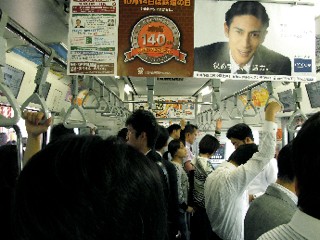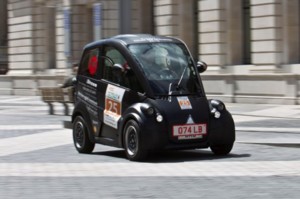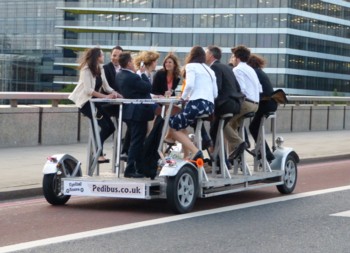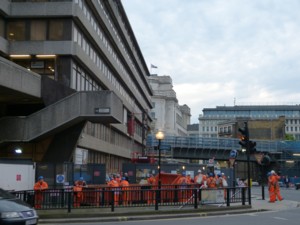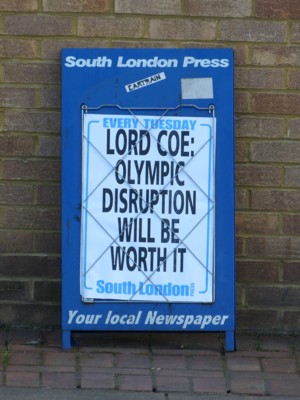We are developing the social individualist meta-context for the future. From the very serious to the extremely frivolous... lets see what is on the mind of the Samizdata people.
Samizdata, derived from Samizdat /n. - a system of clandestine publication of banned literature in the USSR [Russ.,= self-publishing house]
|
“I fly out of Monterey airport, a small airport, a lot and so I’ve gotten to know a number of the TSA employees. This morning, on my way to Miami [I’m writing this from LAX], the “gatekeeper” who asks for ID told the man in front of me, after looking at his ID, that he didn’t have to take off his shoes. When it came my turn, I asked her if I had heard correctly. She said, “Yes, as long as you were born in 1937 or earlier.” “I’m not there yet,” I said. Then I ended up behind him in the next line where you put your items on the conveyor belt. “Well,” I said to him, “I know something about your age.” He grinned and said, “Yes, it seems as if there’s a little common sense sneaking back in.” The TSA guy, whom I also recognized and who also probably recognized me, grinned and said, “Shhh, don’t mention the c-word.” We all laughed. A nice little moment.”
David Henderson, at Econlog.
When I recently flew into San Francisco airport, the queues were long but – and this might just be my being lucky – the guy who checked my passport and details was friendly, helpful and efficient. (He was ex-Air Force and did his military service near where I was brought up, a fact that he told me with great delight). Perhaps someone has told the TSA to improve.
The traffic in the blackout areas of Manhattan is lawless in the most literal sense: the traffic lights aren’t working, so the law cannot be applied as usual. But “lawless” doesn’t seem to be a fitting description; the driving seems better-behaved than usual. We’re so used to seeing people act under a system of government rules that it’s easy to assume that without the rules, everything would descend into chaos. But perhaps free people are generally capable of acting decently on their own. Of course, that’s never going to be universal; but then, people break the law too. In fact, a dense set of rules tempts people to see how close to (or how far across) the borderline of legality they can go without being penalized. In the absence of governmental laws, people might focus more on other kinds of laws: social norms and ethics.
– This quote was, at the time I reposted it here, prominently featured near the top of Instapundit. But Instapundit moves fast, especially now, when there are about half a dozen of them and they’ve a presidential election to be blogging about. So the above wisdom will soon have been and gone. It deserves to linger longer, I think, and here, it will. A little longer anyway.
Instapundit found it here, and also links, again, to a piece saying that too many traffic rules can make us less safe.
For traffic rules read rules of every sort.
A couple of weeks ago the government announced (with pens hovering over contracts) that it was prematurely ending the process for awarding the West Coast Main Line (WCML) franchise. This came after Virgin – the loser – initiated legal action to force the government to disclose why it had provisionally awarded the contract to First. During the process of preparing for the case the Government discovered that it had got its sums wrong.
We can argue that it shows that the government is incompetent. We can argue that it shows that Beardie is not a man you want to mess with. We can possibly argue that over-optimistic assumptions about the economy have a lot to do with this. And we can certainly argue that this creates a lot of uncertainty and this is a bad thing because train operators will not be able to make any plans.
But really this is wood for the trees stuff. The fact is that the government (or, to put it another way, the violent part of society) should have nothing to do with the railway. Decisions about the railway should be made by the market (i.e. the peaceful part of society).
Hence, we shouldn’t have franchising, or subsidy, or the split between the wheel and the rail. Yes, unbelievable as it may sound to the uninitiated, in Britain train operators are not allowed to own the track and track owners (or owner – there’s only one) are not allowed to run trains. Railways should be liberated from the state and allowed to stand or fall on their own merits.
My guess is that they will stand (or at least the WCML will). I’ve just returned from Japan where the railways were (mostly) liberated from the state 25 years ago. Trains are frequent, clean and modern. The main railways are profitable.
At this point people someone’s bound to complain that Japanese trains are overcrowded. What about all those people pushers? Every time I’ve been in Tokyo (this was my fourth trip) I’ve tried to find them and haven’t succeeded yet. True, most people have to stand in the rush hour, and from time to time things get very uncomfortable but much the same is true of London too. And for the same reason: fare control which depresses the price and increases demand.
Yamanote Line train somewhere between Shinagawa and Shibuya 0730, Thursday 11 October 2012:
I have loved David Thompson’s Friday ephemera postings ever since they started, and the latest list contains something I especially enjoyed finding out about.
You wouldn’t think it would be possible to make the bicycle an order of magnitude more simple, but it would appear that the bicymple is just that. Instead of that big triangular bicycle frame in the middle, they just have a single strut across the top. The wheels are as near to each other as they can be without bumping into each other. The pedals of the bicymple are attached to the middle of the back wheel, which gets rid of the chain.
Unridable? Well, here is a video of a guy riding it. And here is an interview with the inventor.
The world is full of bizarre transport gadgets that “work”, in the merely mechanical sense, but which nobody seems to want to use for anything other than pratting about in pointlessly. So, whether the bicymple will ever catch on in a significant way is anybody’s guess. My guess is a definite maybe. I will sit decisively on the fence, and wait to see what happens with this strange little contraption.
All I can say with certainty is that I am looking forward to reading any guesses about the possible future of this bizarre gizmo that our often very tech-savvy commentariat feels inclined to offer.
And not just in the obvious way, by selling me interesting books, cheaply, that I might not otherwise be able to get hold of.
It happened like this. The block of flats I inhabit has a door at the bottom which each of us can unlock from our flats with a remote control button, without seeing who we are letting in. This makes us vulnerable to robberies. What happened was that the buzzer went, and one of us would pick up his phone. A voice would say: “I am the postman”, or “I have a delivery for number 22”, or “I have come to read the electricity meters”, or “I live in number 29 and I don’t have my key on me”. It only needed one such person to be a plunderer and a liar, and one trusting householder to trust the liar, and the liar was inside the building able to steal any enticing parcels from the post boxes just inside the front door.
We don’t have a concierge, and we don’t have postal boxes that are locked. (Which may be why blocks of flats are now, more and more, big. They are big enough for all the dwellers in them to be able, between them, to afford a concierge.)
So anyway, this all makes it impossible for me now, in full confidence, to receive purchases from Amazon. They get delivered fine. But they are then liable to be stolen.
We have all learned about this, and I for one do not let people in without coming down and personally seeing them in and out. I get the impression that robberies have now abated, and the robbers have moved on. But, why take the chance? Why not, instead of getting Amazon stuff delivered to a home like mine, get it delivered to the home of a friend with no such problems, just his own single front door? Why not drop by every now and again to collect whatever Amazon stuff you order?
So it is that, instead of getting Amazon stuff for me delivered to my own home, it now all goes to Chateau Samizdata, the home of Perry de Havilland. And so it also is that I have yet another excuse for dropping by to visit Chateau Samizdata every so often, every time stuff needs collecting.
This is good in itself. There is nothing like face to face contact with good friends. Samizdata is all very virtual and twenty first century and all, but it started when people met each other face to face, and it works better if we keep on meeting in this old fashioned way from time to time.
But travelling to Chateau Samizdata has another benefit, for me. → Continue reading: How Amazon is causing me to read more books and read them better
Occasionally a taxi driver will complain to me about the costs of licensing or the expensive safety test he is about to send his car in for. I always suggest that there is no need for taxi licensing at all. The taxi driver does not like this one bit. Of course not: the main purpose of licensing is to restrict supply and keep prices high.
This is rarely admitted. Instead we are warned of the dangers of unlicensed taxis. And dangers there are, but it is nothing that can not be solved with private certification schemes or branding.
The makers of a smartphone app called Uber are currently having various battles with taxi licensing authorities. They want to make it easier for people to order and pay for taxis and presumably in return take a cut of the fares. Price controls, metering and rules about how drivers are paid are getting in their way.
Meanwhile in Chennai, auto-rickshaws (known elsewhere as tuk tuks) are not metered. There is a campaign to have meters installed in them to fix the prices along with “proper” regulation and licensing. One problem people are complaining about is high prices; another is the behaviour of drivers, such as choosing customers and forcing people to share rides. These problems suggest to me that there is a shortage of auto-rickshaws, but my friend from Chennai disagrees. She explains that there are plenty of drivers, but they agree amongst themselves who will take which passenger so that passengers can not choose between drivers to get a better deal. This sounds like union behaviour, and an obvious question with perhaps an obvious answer is: what stops drivers operating outside of the union?
Here is a typical comment from the Missing Meter Facebook page:
the auto stand in my area itself (near perungudi bus stop – OMR)…… they will ask triple the charge if they see me in urge of going (dressed like professional)…. they will not let the autos to stop which are passing by… so we will end up in negotiating with those guys & pay atleast double the amount of real charge… apprx – 20 rs / km… this happens almost all the time….
Establishing free markets is never easy.
Photoed by me in Vauxhall Bridge Road, earlier this week:
I liked this enough when I first set eyes on it to snap it up, and that was two days before I even noticed the “we’ve got one ‘ere” bit. Like I always say, my camera regularly sees more than I do.
Website here.
Last night I watched a television documentary about the career and achievements of Gordon Murray, a very different Murray from the tennis Murray whom I mentioned here on Saturday. Gordon Murray designs cars.
He started out doing racing cars. Time was when Gordon Murray was applying his extraordinary ingenuity to designing such things as “improvements” to McLaren racing cars, improvements whose only rationale was that they drove through some silly loophole in the rules of Formula 1 racing, a loophole that would soon close and render the new design feature utterly pointless. Okay, F1 is fun, and okay, most of what Murray did was make F1 cars go ever faster and get ever cleverer. But that rule-dodging bit in particular seemed like a serious waste of a talent, and I am sure the television people intended it to.
But Gordon Murray then took a big step towards applying his stellar engineering skills to a task more worthy of them when he designed the McLaren F1, which is the fastest car that multi-millionaires can buy to drive on regular roads. Better.
And now, Murray has designed a small car. This small car looks like a superior version of one of those covered over motorbikes, but actually it is a lot cleverer and more capacious than that. It is cleverer because it embodies half a lifetime of Murray’s experience in Formula 1, making everything in cars lighter, smaller and just plain better.
There are many ways to innovate. A good way is to innovate in just one aspect of a design, while relying on tried and tested technology for everything else. That way there is only one thing to go wrong and to get right. Very wise.
But Gordon Murray’s way is different. More “courageous”, you might say. He looks at everything. He looked at small cars the way huge teams of aircraft designers are perpetually looking at aircraft design, chiselling little ounces of bulk from here, there and everywhere, and where possible trying more serious rethinkings and rearrangements, adding up to a seriously improved product.
Innovation done this way can unleash a ton of mistakes, with all the good ideas getting overwhelmed by a few bad ones. Everything has to work. You have to get, near enough, a hundred out of a hundred, or you fail. You need lots of skill and experience to get a score like that. Gordon Murray, it would seem, has an abundance of both.
In particular, just as a for instance, this small car is interesting (courageous?) in using the same seating arrangement as the McLaren F1. In the McLaren F1, instead of the driver sitting on one side at the front, and then another bunch of people sitting behind on another big seat, or not, the F1 has the driver in the front in the middle, and two other seats on either side, but set back, in an arrow formation. The passengers can presumably stretch out their legs beside the driver’s bum. And the new small car has just the same seating set-up. Which makes it feel bigger inside than a regular small car, but much less bulky from outside.
Also, the doors to the new small car are an all-in-one door, which opens up and forward, like the top of an airplane. Combined with that seating arrangement, this makes it easier to get in and out of than the competition.
This small car comes in two versions. There is the black T25, which is petrol driven, and which looks like this:
And there is the blue version, the T27, which runs on electricity. They showed the T27 towards the end of the television show, in the company of some veteran cars in a place that looked a lot like central London, and I thought: hang on, this rings a bell. Sure enough, after a little digging in my photo-archives, I found this snap:
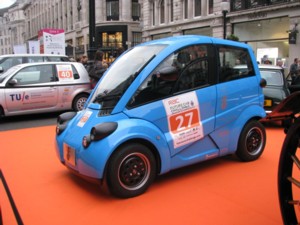 I took that picture of the T27 on the same day, early last November, that I took all these photos of veteran cars in Regent Street. (There is a slice of veteran car there on the right.) I far prefer the look of the black T25. Its strangely retro styling reminds me of a delivery van of the sort I recall from my youth. The blue T27 looks to me, still, like a boring little car only pretending not to be boring, which is why I had no idea how interesting it was when I first set my eyes and my camera on it. Oh me of little faith. Kudos to me, though, for taking “too many” pictures whenever I go out a-snapping. Time and again, as in this case, I only realise later, and sometimes a lot later, what I photoed.
Being so unbulky, this new T25/27 is much more fuel efficient than regular small cars, but its energy efficiency does not stop there. One of the most interesting moments in the programme came when they talked about how this new car will be made. There is more to cars being efficient than cars being efficient to drive. They also have to be as efficient and as cheap and as easy as possible to make, and this new car requires far less in the way of capital investment before you can start cranking them out. The huge manufacturing costs of regular automobiles, said my television, explained why most car makers prefer making expensive cars to cheap cars. Cheap cars don’t make any money. But this cheap car will make money for those who make it, or that’s the idea. That’s another huge potential step forward.
The claim was repeatedly made in this programme that this T25/27 is the biggest innovation in car making since the Model T, what with the revolutionary way that the Model T was manufactured. But the cars that this new gizmo makes me think of are the Citroen 2CV and the Volkswagen, which were likewise designed to be more easy to make than regular cars, were they not? The Citroen 2CV, I seem to recall reading, was banged out by peasants in a big barn, or some such thing, just after WW2, when manufacturing skills were scarce. This seems a lot like the T25/27 plan, which is a twenty first century version (i.e. with shipped in magic bits) of the same thing.
The T25/27 secret, apparently, is that the structural frame of the car is made of metal tubing, and that is far easier for cheapo, Third World type fabricators to work with than however small cars are made now, by the likes of Toyota and Ford and the rest of them.
The upshot of all this is that here is a small car, a truly small car, that will make regular non-multi-millionaire motoring massively less of an energy gobbler.
Which in fact means, if it all goes to plan, that many more people will drive around in such cars than drive around in any cars now, and the total amount of energy consumed by these cars as they wizz hither and thither will then go up. But, a lot more people will be having fun and getting themselves and their stuff from A to B. So: very good.
Or, it could be that too many of Gordon Murray’s innovations will turn out to be mistakes, in which case car historians may point back to the T25/27, to say where Toyota and Ford got their next bunch of ideas, while the rest of us may soon forget this most interesting and admirable man. What if, for example, we regular punters just can’t be doing with that strange new seating arrangement? What if drivers just have to have company sitting right next to them when driving? And what if that radically rethought manufacturing method turns out to have too many mistakes built into it? So maybe the T25/27 will go down in car history as an heroic failure, rather than getting flagged up as a triumph, Volkswagen or Deux Chevaux style. It may be remembered, that is to say, as a very gutsy shot at a real car that was actually only a concept car. We shall see.
Earlier yesterday, in the afternoon, I caught Jenson Button and Lewis Hamilton moaning on the telly about their (McLaren) racing cars had been way off the pace in the British Grand Prix. Are they missing Gordon Murray, I wonder?
If the ten day London weather forecast is anything to go by, and I think it is, yesterday was the last day of nice weather that London will see for quite a while, again. So yesterday, thus forewarned, I made a point of going out and about in London, photoing. (Longer range weather forecasts are an entirely different matter.) Sure enough, the weather was excellent, except at the end when it started clouding over.
And one of the more diverting things I observed and photoed was this, on London Bridge:
Yes, it’s a Pedibus. Even though Transport Blog is now in a state of permanent repose, I acquired the habit of photoing any strange form of transport I observed, so that I could feature it there, in among all the droning on about rail privatisation, and the habit of taking weird transport photos whenever the chance arose stuck. Also, the above photo is yet another in my now vast collection of people taking photos.
Although, I really should have videoed it to do it justice.
The people actually powering that particular Pedibus look suspiciously young, attractive, healthy and gender-balanced to me. I suspect they are promoting the thing, rather than actually paying to use it. (Peddling it as well as pedalling it, you might say. (See first two comments.))
But I reckon that if that is mere promotion, it ought to work. The Pedibus, it seems to me, unites a number of modern obsessions all into one activity, obsessions such as:
– Sitting at a table with friends, shouting nonsense.
– Showing off by doing something very weird in public.
– Drinking alcohol.
– Pedophilia, i.e. taking exercise by sitting on some sort of pedalling device, perhaps a bicycle of some sort but often just a thing with only pedals.
– Greenery. You can imagine yourself not having not such a big carbon footprint as you might have, while doing this.
I also think that it may appeal to all those who favour pedalling but who are reluctant simply to be pedalled around by someone else, because that seems just too Third Worldish, and who are reluctant to pedal around London alone because it seems too scary.
Best of all, because (although you can’t see him in my picture) there is a person at the front steering, you get to do, sort of, drunk driving. Perhaps Londoners will rename this contraption the Pub Crawler, because it would be ideal for that.
Even bester, it would seem that you don’t have to wear a helmet, which will surely rile all the cyclists, either because the cyclists wish they didn’t have to wear helmets, or because they think everyone else doing anything at all similar to them (walking along the pavement for example) should also be compelled by law to wear helmets.
Bestest of all, the Pedibus annoys the hell out of pompous git licensed taxi drivers.
Next, Pedibus racing. I googled those two words to see if that was already happening. Apparently not, but I did learn that “pedibus” is the Latin for something or other to do with ancient Roman chariot racing. Although I couldn’t be bothered to work out what.
I love London.
A thing I keep banging on about is that a crucial stage in an argument occurs when the burden of proof gets reversed.
Crackpot Theorists devise a Crackpot Theory. It unites them. It excites them. It excuses their shared belief that The Free Market Is Not Good Enough. They demand action from each other. They capture small parts of government departments that most people don’t give a damn about. They write small laws and get them passed.
A few Critics notice, and start explaining that the Crackpot Theory is, maybe, a crackpot theory. The Crackpot Theorists say: No it isn’t! The Critics say: But you are making bad decisions! The Crackpot Theorists say: No we aren’t! As this phase of the argument gets seriously going, the Critics become ever more convinced that the Crackpot Theorists are indeed Crackpot Theorists, and because the Crackpot Theorists are behaving like the maniacal Crackpot Theorists that they are, the Critics grow in number, and in their certainty that the Crackpot Theorists are totally crackpot.
The small bits of the government departments grow into big bits, and infect other bits. The laws they introduce get bigger and more intrusive.
But sadly, nobody else cares, or not enough to stop all this. The money and inconvenience involved is still trivial, by the usual standards of government-imposed expense and inconvenience. Let the Crackpot Theorists have their fun! And besides: Maybe, just maybe, the Crackpot Theorists are onto something. Better safe than sorry! Anyway, what can you do?
As the Crackpot Theory grows in power, powerless people start to notice and to cry out: Your Crackpot Theory is just an excuse for us to be taxed more! Alas, for many people this is a feature, not a bug.
Throughout this phase of the history of the Crackpot Theory, the Critics of the Crackpot Theory are in the impossible position of having only one way of stopping the rise to prominence of the Crackpot Theory, which is to convince the Crackpot Theorists that they are wrong.
Some Crackpot Theorists are convinced. Quite a few of them creep away in ashamed silence. A tiny few even say in public that they were wrong. But others of them are now so wholly dependent for their livelihoods upon the Crackpot Theory being true that they stick with it anyway, despite now suspecting or even knowing what total crackpottery it is. What can they do?
Until, one day, the Crackpot Theorists pick a fight with a group of people powerful enough for their anger to actually matter, to the entire world.
At which point, the burden of proof, hitherto weighing down only upon the shoulders of the Critics, now descends upon the shoulders of the Crackpot Theorists themselves. Suddenly, they have to convince the world that they are right and that their Critics are wrong. They have to convince their Critics that their Critics are wrong, just to shut their Critics up from saying what the world now wants to be told, namely that the fight with those powerful and angry people is a fight that is not worth having.
But our Crackpot Theory says that we must have this fight! No matter what! The world must be saved, even if it is ruined in the process!
I’m just thinking aloud, you understand. Having seen this (linked to just now by the ever-alert Instapundit):
China will take swift counter-measures that could include impounding European aircraft if the EU punishes Chinese airlines for not complying with its scheme to curb carbon emissions, the China Air Transport Association said on Tuesday.
Wei Zhenzhong, secretary general of the China Air Transport Association, said:
“We would try to avoid any trade war.”
If that’s not a powerful and angry person threatening a trade war, I don’t know what is. If the trade war duly happens, next up: trade war. (What was that about the EU putting an end to conflict between Great Powers?)
So, Crackpot Theorists, is your Crackpot Theory true enough to be worth stuff like this? Go ahead. Convince us.
One of the little pleasures of my life is looking back through old photo-archives and finding pictures that particularly amuse, in ways that I did register when taking them (otherwise I would not have taken them), but then forgot about.
So this morning, for instance, while looking through some pictures I took earlier in the month of the remarkable (because so remarkably ugly) Baynard House, I came across this picture:
Yes, it is ugly, isn’t it? But what interested me when I took that photo was also all those Men in Orange. What were they up to? What struck me at the time, and I distinctly remember this feeling now, was what an alarmingly large number of Men In Orange there were. It was like they were making an action movie and about to be slaughtered by James Bond or by a James Bond imitator, or perhaps even plotting an urban atrocity of some sort themselves, for real. None of the photos I took of these many, many Men In Orange quite captures the scary oddity of them, congregated in such an alarmingly large number. The above snap was only the least unsuccessful from this point of view.
So it was that, when I encountered this sign on the side of Baynard House a few moments later, I was amused, and not wholly surprised:
Click to make that more legible.
What the Men In Orange are doing is some major rearranging of Blackfriars tube station. Blackfriars Station as a whole, including an overground railway station that straddles the Thames on Blackfriars Bridge, is being entirely reconstructed, and the underground bit with it. (I show a couple more shots of the overground aspect of all this activity here.) Merely the London Underground (LU) aspect of this is a big job, which requires the attentions of Men In Orange in large numbers.
The above snaps were taken when I was on my way to One New Change. The process of writing about One New Change caused me to forget my strange encounter with the Men In Orange, until prompted to remember the experience this morning, thanks to the magic of digital photography and the infinitely capacious hard drives that computers have in them nowadays.
Here is a photo I took in March of this year, which I have been meaning to feature here for ages:
We shall see.
One of the many annoying things about the Olympic Games is how little clutches of contractors and workers, doing vital things, know that they can, during the frantic run-up to the Olympics, demand a hugely exorbitant price for merely doing their job, even if they had earlier sworn blind that they would not behave like this. I imagine that’s a very widespread Olympic phenomenon generally, which adds hugely to the final bill, and is just one more reason why I wish the damn things had gone to Paris and never come back, ever.
I surmise – no speculation of this sort could easily be proved – that if any such demand becomes just too demanding, the means used by the State to settle such demands are not confined to bribery. If I was the State, I’d also now be issuing threats. I’d send people round to knock on doors to explain, ever so politely (perhaps over a friendly cup of tea), to such persons as trade unionists and building contractors, just how nasty the State is now capable of being, to individual people whom it has taken against. The State knows where you live. The State decides how much tax you owe it. And so on. And it could get even nastier. So, don’t push your luck too far, there’s a good fellow.
This is all pure speculation on my part. I have zero inside knowledge of any such negotiations. It’s just that if that were now happening, I would not be surprised, whereas if it wasn’t, I would be very surprised indeed.
Another way of responding to such last minute demands is to say: Okay, if you don’t finish it in time, you don’t finish it in time and it doesn’t get finished in time. Pity, but there you go. And once the Olympic Games are over, we can then sack the damn lot of you and take our time. While keeping all your names on a Black List, for you to be suitably punished at our leisure.
This seems to be the approach being adopted in the matter of the Greenwich Cable Car. I am particularly interested in this New London Thing because, when finally finished and open for business, it will be another fine photo-op for me, to add to my London list of places like this.
Yes, says Mayor Boris, we do indeed hope that the Emirates Airline will be ready in time for the Olympics, as another way to get people back and forth across the river, to and from all that Olympicism. But if it isn’t ready by then, so be it. This is not an “Olympic Project”, or it only will be if it is ready for the Olympics.
Very wise.
I recall that the London Eye was supposed to be ready for the Millennium, but that, perhaps for the kind of reasons speculated about above, it wasn’t. Who now cares?
Pity you can’t take that line with such things as velodromes and swimming pools. Which is why I suspect that other means of persuasion are also now being deployed.
|
Who Are We? The Samizdata people are a bunch of sinister and heavily armed globalist illuminati who seek to infect the entire world with the values of personal liberty and several property. Amongst our many crimes is a sense of humour and the intermittent use of British spelling.
We are also a varied group made up of social individualists, classical liberals, whigs, libertarians, extropians, futurists, ‘Porcupines’, Karl Popper fetishists, recovering neo-conservatives, crazed Ayn Rand worshipers, over-caffeinated Virginia Postrel devotees, witty Frédéric Bastiat wannabes, cypherpunks, minarchists, kritarchists and wild-eyed anarcho-capitalists from Britain, North America, Australia and Europe.
|
